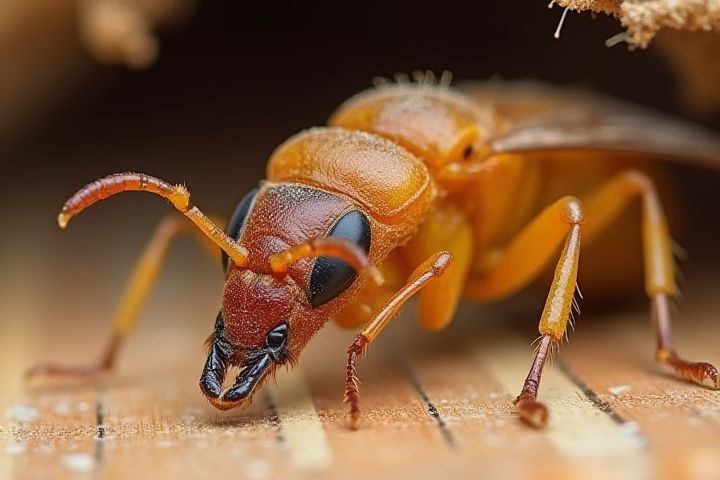
Signs of house termites include mud tubes, which are small tunnels made of soil and wood that termites use for protection while traveling between their nests and food sources. You might also notice discarded wings, as reproductive termites shed their wings after swarming and mating, often leaving these behind near windows or doors. Hollow-sounding wood is another telltale sign; if you tap on wooden structures and detect a hollow sound, it could indicate internal damage from feeding termites. Furthermore, frass, or termite droppings, resembles small pellets and is often found near infested areas, indicating active feeding. Regular inspections can help you identify these signs early and take necessary action to protect your home from potential damage.
What Are Signs Of House Termites
Mud tubes on walls or foundations
Mud tubes, cylindrical structures made from soil and wood particles, are prominent indicators of termite activity, often found along walls or foundations. These tunnels, which can be as thin as a pencil or wider, provide protection for termites traveling between their nest and food sources. If you notice these tubes, it is crucial to inspect the surrounding areas for other signs of infestation, such as discarded wings or hollow-sounding wood. Act promptly, as termites can cause significant structural damage, with colonies consuming up to 13 ounces of wood per day.
Hollow-sounding wood
Hollow-sounding wood is a prominent indicator that your home may be infested with termites. When termites consume the interior wood, they leave a thin veneer on the surface, creating a hollow sound when tapped. Inspect areas like door frames, wooden beams, and floorboards, as these are common targets for termite activity. If you notice this auditory change, it's crucial to consult a pest control expert to assess the extent of the infestation and recommend treatment options.
Swollen or buckling floors
Swollen or buckling floors are clear indicators of potential termite infestation, often signaling moisture damage or compromised structural integrity. Termites, particularly Subterranean species, can cause significant harm by feeding on wood and other cellulose materials, leading to weakened floor support. If you notice areas of your flooring that appear raised or warped, it may suggest that termites have been nesting nearby or actively damaging the property. Prompt inspection by a professional can help identify the extent of the problem and determine appropriate treatment options to protect your home.
Discarded wings near windows or doors
Discarded wings near windows or doors are a prominent sign of termite infestation, indicating that these pests have entered your home. These wings, often found in clusters, are remnants of swarmers, or reproductive termites, that have left the colony to establish new nests. The presence of these wings suggests that there may be a larger colony nearby, potentially compromising the structural integrity of your property. Regularly inspecting these areas can help you detect an infestation early, allowing for timely intervention and pest control measures.
Small pellet-like droppings
Small pellet-like droppings, often resembling grains of sand or coffee grounds, are a primary indication of termite activity in your home. These droppings, known as frass, are comprised of digested wood and can often be found near termite nests or areas where wood is being consumed. If you notice these pellets accumulating around wooden structures, it's crucial to inspect for underlying infestations, as they can indicate a larger colony nearby. Early detection of these signs can prevent extensive damage and potentially save you significant repair costs.
Blistered or damaged paint
Blistered or damaged paint on your walls can be a clear indication of termite infestation, especially in areas where wood structures are present. This damage often occurs because termites consume the wood beneath the surface, causing the paint to bubble or peel away. If you notice these signs, it's essential to inspect the underlying wood for hollow areas or droppings, which can further confirm the presence of termites. Regular inspection and maintenance of your home's exterior can help prevent these pests from causing significant structural damage.
Tight-fitting doors or windows
Tight-fitting doors or windows can be a strong indicator of a termite infestation in your home. When termites consume wood, they can damage structural components, leading to misalignments that cause doors and windows to stick or not close properly. This structural distortion may become more evident over time, particularly as the infestation grows. If you notice these issues alongside other signs like mud tubes or discarded wings, it's essential to take immediate action to protect your property from further damage.
Clicking sounds within walls
Clicking sounds within walls often signify the presence of termites, specifically the soldier caste, which communicates by tapping their heads against wood. This distinct noise typically occurs when a colony is disturbing the wood structure, and can often be heard in homes, especially in areas with moisture. According to pest control experts, the wood they infest can exhibit additional signs, such as frass--tiny wood pellets--or hollowed-out sections. If you hear persistent clicking sounds, it's crucial to conduct a thorough inspection, as termites can cause significant structural damage if left untreated.
Termite swarmers indoors
Termite swarmers, or reproductive adults, are a critical sign of a potential termite infestation in your home. Typically, these insects are attracted to light and may be seen flying around windows, doors, or light fixtures, indicating a nearby colony. When you find discarded wings on windowsills or floors, this further suggests that swarmers have emerged indoors. It's essential to address these signs promptly, as an active termite colony can cause significant structural damage to your property.
Visible mazes within wood structures
Visible mazes within wood structures are a telling sign of termite activity, indicating the presence of these destructive pests. These intricate tunnels, often resembling a honeycomb pattern, result from termites consuming wood and creating galleries for nesting and movement. Typically, you may notice these signs in damp or damaged wood areas, particularly around the foundation, beams, and flooring. Early detection of these visible mazes can save homeowners thousands of dollars in potential repairs and restorations.
